Global Down Syndrome Foundation Advocacy Leads to $23 Million Increase for Down Syndrome Research at the NIH
August 2nd, 2019 by Global Down Syndrome Foundation
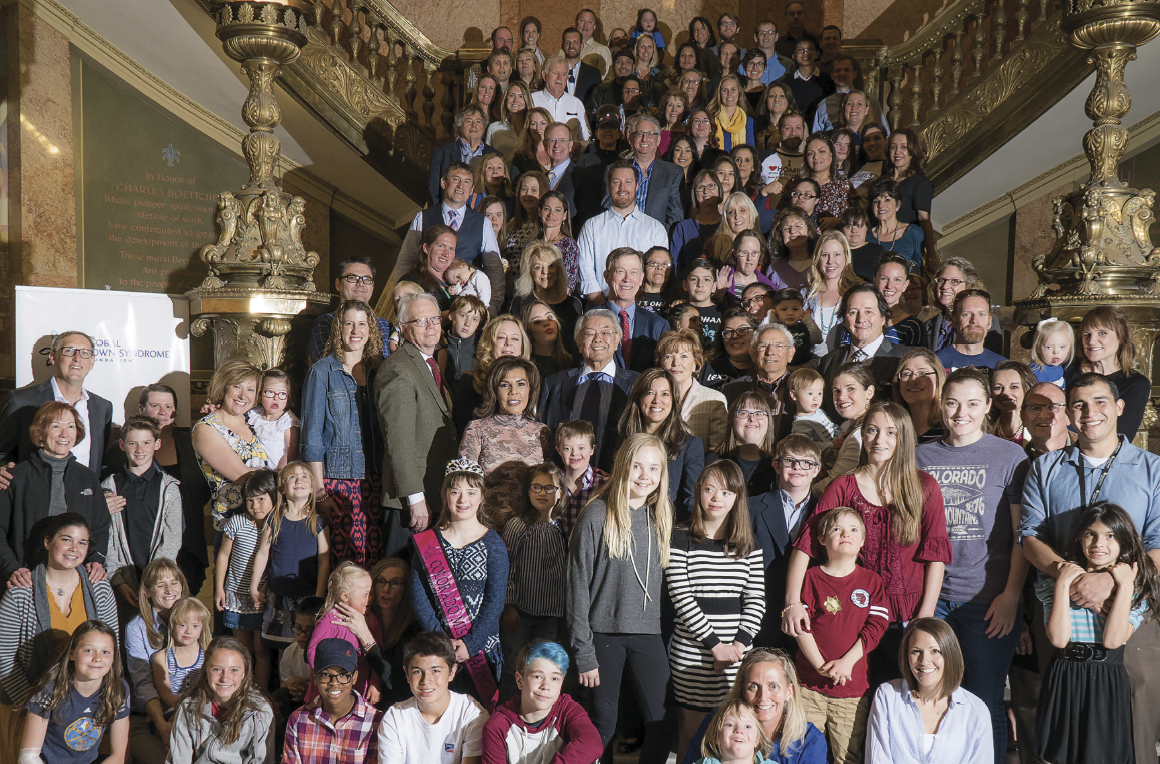
From Down Syndrome WorldTM Issue 3 2018
THANKS TO GLOBAL’S GROWING NATIONWIDE NETWORK OF ADVOCATES AND SELF-ADVOCATES, BRILLIANT AND PASSIONATE SCIENTISTS, AND OUR CONGRESSIONAL CHAMPIONS — SENATORS ROY BLUNT (R-MO), PATTY MURRAY (D-WA), AND CHRIS VAN HOLLEN (D-MD), AND REPRESENTATIVES TOM COLE (R-OK), ROSA DELAURO (D-CT), CATHY MCMORRIS RODGERS (R-WA), AND PETE SESSIONS (R-TX) — DOWN SYNDROME RESEARCH HAS A NEW HOME AT THE NATIONAL INSTITUTES OF HEALTH AND, FOR THE FIRST TIME IN 20 YEARS, HAS RECEIVED ITS FIRST REAL BOOST IN FUNDING. THE AGENCY’S “INCLUDE” PROJECT SPELLS OUT EXACTLY HOW THESE HARD-EARNED FUNDS WILL BE USED.
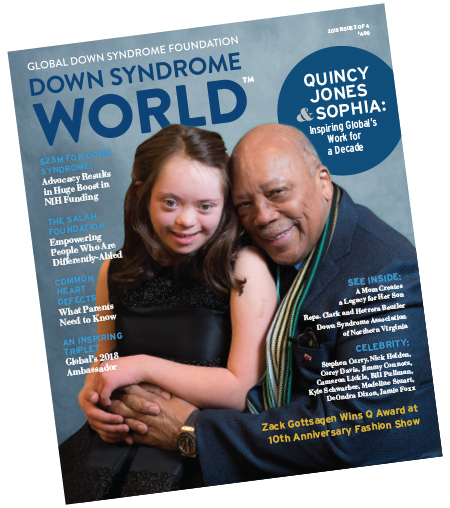 This article was published in the award-winning Down Syndrome World™ magazine. Become a member to read all the articles and get future issues delivered to your door!
This article was published in the award-winning Down Syndrome World™ magazine. Become a member to read all the articles and get future issues delivered to your door! IN 2003, MICHELLE SIE WHITTEN gave birth to her first child, Sophia, who happens to have Down syndrome. On a mission to understand how to increase lifespan and improve health outcomes and quality of life, Whitten found herself meeting with then-Director of the National Institutes of Health (NIH), Elias Zerhouni, M.D. Dr. Zerhouni informed Whitten that despite being the leading cause of developmental delay in the U.S. and the world, Down syndrome
was one of the least-funded genetic conditions by the NIH, and he gave her an important piece of advice: “If you do just one thing, create an academic home for Down syndrome research … and rebuild the pipeline of science.”
And so started Whitten’s journey establishing the Global Down Syndrome Foundation and the Linda Crnic Institute for Down Syndrome, focused on research and medical care.
“Following that meeting, we started traveling to Washington, D.C. almost every month to educate Congress and the NIH on this issue,” says Whitten, President and CEO of Global.
“We met so many families whose children had health issues, and they helped us with petitions, phone calls, letter writing, and face-to-face meetings. In our very first letter writing campaign, 1,000 people contacted Congress advocating for more Down syndrome research funding. It wasn’t easy, and it would take a decade to succeed, but we made it happen!”
Fortunately, Global was able to attract scientists “brilliant of mind and heart” — Tom Blumenthal, Ph.D., Joaquín Espinosa, Ph.D., and Huntington Potter, Ph.D. Dr. Espinosa, now the Executive Director of the Crnic Institute, has clearly mapped out how people with Down syndrome have a different “disease spectrum” where they are highly predisposed or protected from major diseases that represent 60 percent of all the deaths in the U .S. Most importantly he made a game-changing discovery recasting Down syndrome as an immune system disorder.
Armed with the support of the Down syndrome community and groundbreaking science, the pivotal point for Global came in fall 2017. On Wednesday, Oct. 25, 2017, for the first time in its history, the Appropriations Subcommittee on Labor, Health and Human Services, Education, and Related Agencies, which provides federal funding for the NIH, held a hearing on current and future research funding priorities for people with Down syndrome. The hearing included testimonies from Global and the Crnic Institute. Global had two goals: to move Down syndrome under a trans-NIH structure, since the condition touches so man y diseases, and to reverse the terrible disparity of funding.
The results were astounding, with the entire committee standing in ovation at the end of the hearing , primarily for the self-advocate testimony by Frank Stephens. The subsequent NIH funding increase was clearly led by Congressional champions: Chairs Rep. Cole and Sen. Blunt and Ranking Members Rep. DeLauro and Sen. Murray, as
well as Reps. McMorris Rodgers, Sessions, Mike Coffman (R-CO), and Cheri Bustos (D -IL).
At Global’s inaugural AcceptAbility Gala in Washington, D.C., Rep. Cole announced the historic and significant $23 million increase in Down syndrome research funding at the NIH from $35 million in fiscal year (FY) 2017 to $58 million in FY2018. A subsequent $98 million has been budgeted for FY2019.
The NIH has embraced the FY2018 Omnibus Appropriations Report and has created a truly trans-NIH effort. Under the office of the Director, Down syndrome research will now be managed by the trans-NIH consortium “INCLUDE” (INvestigation of Co-occurring conditions across the Lifespan to Understand Down syndromE). Eighteen NIH institutes and centers comprise the consortium, and the steering committee is led by three great supporters of Down syndrome research: Lawrence Tabak, D.D.S., Ph.D., NIH Principal Deputy Director and INCLUDE Chair; Diana Bianchi, M.D., Director of the Eunice Kennedy Shriver National Institute of Child Health and Human Development (NICHD); and Gary Gibbons, M.D., Director of the National Heart, Lung, and Blood Institute.
The FY2018 Omnibus Appropriations Report stated the following: “Down syndrome. The agreement directs the NIH Director to develop a new trans-NIH initiative — involving, at a minimum, NICHD, National Institute on Aging (NIA), and National Cancer Institute (NCI) — to study trisomy 21, with the aim of yielding scientific discoveries to improve the health and neurodevelopment of individuals with Down syndrome and typical individuals at risk for Alzheimer’s disease, cancer, cardiovascular disease, immune system dysregulation, and autism, among others. This initiative shall bring together research results that will be available to academic researchers, nonprofit organizations, and industry researchers. Funding for this trans-NIH initiative will supplement, not supplant, existing NIH funding levels for Down syndrome research.”
Like this article? Join Global Down Syndrome Foundation’s Membership program today to receive 4 issues of the quarterly award-winning publication, plus access to 4 seasonal educational Webinar Series, and eligibility to apply for Global’s Employment and Educational Grants.
Register today at downsyndromeworld.org!
Dating and Down Syndrome
July 18th, 2019 by Global Down Syndrome Foundation
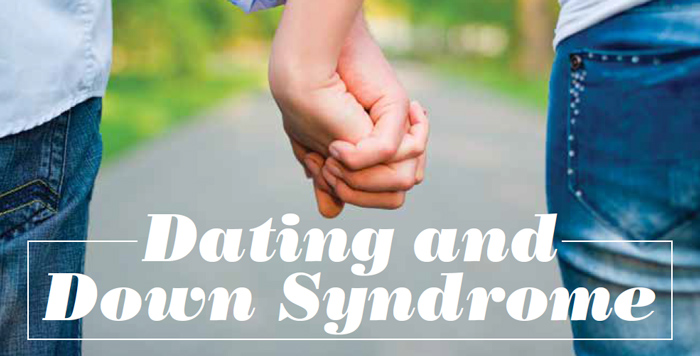
Recognizing your child is ready to enter the dating scene isn’t always easy. Noted sexuality educator Terri Couwenhoven helps both children with Down syndrome and their parents navigate these difficult waters.
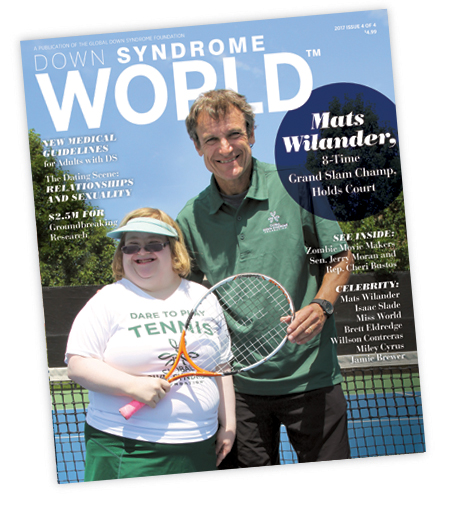 This article was published in the award-winning Down Syndrome World™ magazine. Become a member to read all the articles and get future issues delivered to your door!
This article was published in the award-winning Down Syndrome World™ magazine. Become a member to read all the articles and get future issues delivered to your door! RELATIONSHIPS GIVE EVERYONE a chance to love and be loved, avoid loneliness and depression, and gain self-esteem — and people with Down syndrome have the same right to these relationships as typical teens and adults.
However, “it’s common for people with Down syndrome to experience oppression, denial, and control over the same sexual aspects of being human that typical adults enjoy in their lives,” said Terri Couwenhoven, M.S., AASECT, Certified Sexuality Educator. “This can lead to a denial of feelings and a reluctance to express themselves.”
That denial can perpetuate the myth that people with Down syndrome are asexual, she said. Parents can, and should, take the lead in helping their children develop the foundations of healthy relationships, and Couwenhoven shared three key tips for parents to approach the subject of dating and relationships.
ATTITUDE MATTERS
Parents need to have a positive attitude toward their teenager’s or adult child’s dating.
“Let’s face it, parents are influential in the dating scene for teens and adults with Down syndrome,” Couwenhoven said. “In addition to making sure their children have active social lives so they have access to potential partners, parents often need to coordinate, help plan, transport, chaperone, and coach — at least initially.”
Parents also serve as role models. Engage in honest and open communication with your own partner, and be attentive to your child’s needs.
OFFER CONCRETE INFORMATION ABOUT THE DATING PROCESS
Look for opportunities to explain dating before your son or daughter is old enough to actually date, Couwenhoven advised. For example, if an older sibling has a partner, explain why people date. Use specific language, such as “they spend time dating to see if they are a good match for each other.” If the couple breaks up, you can explain, “not all relationships work out. It takes time to find the right person.”
When your child gets older and develops a crush on someone who doesn’t return the affection, remind him or her that a romantic relationship can’t start unless both people have feelings for or are interested in each other, she added.
LET THEM PRACTICE DATING SKILLS
“Life experience is the greatest teacher of all,” Couwenhoven said. “Chaperoning is an excellent way for inexperienced newbies to practice the rituals of dating in the context of super vision and coaching.”
As your teenagers and young adults with Down syndrome become more mature and gain self-confidence, chaperoning becomes less necessary.
Like this article? Join Global Down Syndrome Foundation’s Membership program today to receive 4 issues of the quarterly award-winning publication, plus access to 4 seasonal educational Webinar Series, and eligibility to apply for Global’s Employment and Educational Grants.
Register today at downsyndromeworld.org!
Congenital Heart Defects and Down Syndrome:
What Parents Should Know
July 3rd, 2019 by Global Down Syndrome Foundation

From Down Syndrome WorldTM Issue 3 2018
This rare disease is significantly more common in children with Down syndrome. Understanding symptoms and early detection could save a life.
CHILDREN WITH DOWN SYNDROME face a high rate of congenital heart defects (CHDs). In fact, about 50 percent of infants with Down syndrome have some form of heart condition, compared with approximately 1 percent of typical infants, although it is unclear why these conditions occur so frequently in children with Down syndrome.
Three of the most common heart conditions seen in children with Down syndrome are atrioventricular septal defect, patent ductus arteriosus, and tetralogy of Fallot.
ATRIOVENTRICULAR SEPTAL DEFECT (AVSD)
AVSD is the most frequently diagnosed congenital heart condition in children with Down syndrome. Various studies place the incidence rate between 30 and 47 percent of CHDs in children with Down syndrome, according to the book Advances in Research on Down Syndrome. A study from the International Journal of Cardiology estimates that AVSD accounts for just 7 percent of CHDs diagnosed in all children. AVSD is characterized by holes between either the upper or lower chambers of the heart, the atria and the ventricles, respectively.
In less severe cases, atrial septal defects (ASD) or ventricular septal defects (VSD) can occur separately. Both are caused by a “hole” in the wall the separates chambers of the heart. ASD affects the top two chambers, while VSD affects the two lower chambers.
AVSD can be diagnosed during pregnancy via ultrasound but may not be evident until a child is a few months to even a few years old. The condition almost always requires surgery, the type of which will vary depending on the kind and degree of AVSD. According to the Society for Thoracic Surgeons, which tracks heart surgery outcomes for all children, AVSD surgeries have a near-100 percent survival rate.
 This article was published in the award-winning Down Syndrome World™ magazine. Become a member to read all the articles and get future issues delivered to your door!
This article was published in the award-winning Down Syndrome World™ magazine. Become a member to read all the articles and get future issues delivered to your door! PATENT DUCTUS ARTERIOSUS (PDA)
PDA accounts for 5 to 10 per cent of all CHDs in full -term infants and between 20 to 60 percent of CHDs in pre-term infants. For children with Down syndrome, it accounts for between 5 and 18 percent. This heart defect occurs when a channel called the ductus arteriosus that connects a fetus’ heart and lungs in utero does not close after birth. While it is frequently diagnosed after birth, not all children exhibit symptoms. When symptoms do exist, they include tiredness, sweating, quick or heavy breathing, disinterest in eating, and not gaining weight as expected in a growing child.
Doctors generally employ four treatments for PDA: watchful waiting to see if the ductus arteriosus closes on its own, nonsteroidal anti-inflammatory medications, surgery, or an outpatient procedure called a transcatheter device closure. Most children undergo catheterization, according to the American Heart Association (AHA), but treatments chosen often depend on a child’s age, degree of symptoms, and whether the particular PDA responds to medications. Children with PDAs have a higher rate of mortality than children whose PDAs are closed with treatment, according to the American Academy of Pediatrics.
TETRALOGY OF FALLOT
This heart defect is fairly rare in all children. The CDC estimates that it occurs in only 1 in 2,518 (0.04 percent) of all live births. However, it accounts for 2 to 6 percent of CHDs in infants with Down syndrome.
Infants with this heart defect have four different problems: a ventricular septal defect, a narrow or obstructed pulmonary valve, an enlarged aorta, and a thicker-than-normal right ventricle. The combination reduces blood oxygen levels in the rest of the body.
Tetralogy of Fallot, which is usually diagnosed after birth, requires an open-heart surgery called complete intracardiac repair. As children grow up, they may need additional surgery to widen or replace a pulmonary valve, which can leak and lead to a condition called pulmonary backflow.
Research suggests that 90 percent of all infants who have surgery for tetralogy of Fallot live into their 40s, according to the Cleveland Clinic Journal of Medicine, but these children often face heart problems, such as arrhythmia and coronary heart disease, later in life and require lifelong follow-up care with a cardiologist.
DETECTING PROBLEMS
Certain CHDs can be diagnosed during pregnancy by a pediatric cardiologist through noninvasive testing, such as ultrasound or fetal echocardiogram. Early diagnosis of cardiac issues is crucial to ensure prompt medical response after delivery and to improve an infant’s chances to survive and thrive. In addition, a pediatric cardiologist provides ongoing care throughout childhood.
Given the frequency of CHDs in babies with Down syndrome and the optimal one-year surgical window, the American Academy of Pediatrics recommends every baby born with Down syndrome be evaluated by a pediatric cardiologist within one month of birth. This
recommendation includes children whose prenatal tests and general pediatrician found no trace of CHDs.
Whether a child with a CHD is diagnosed before or after birth, parents should, if possible, interview more than one pediatric cardiologist and cardiovascular surgeon, if necessary.
It’s also wise to ask an insurance provider about coverage for seeking a second opinion before parents decide on a care plan for their infant.
LONG-TERM PROGNOSIS
Until the early 1970s, providers were reluctant to perform heart surgery on children with Down syndrome who had CHDs, essentially predestining them to a lifetime of hear t problems. Research has since established that babies with Down syndrome fare very well after pediatric heart surgery, and delaying surgery beyond the first year of life increases the risk of problems in adulthood.
“It is much easier to find treatment for children with Down syndrome and heart defects than adults with the same condition,” says Dunbar Ivy, M.D., Professor of Pediatrics–Cardiology at the University of Colorado School of Medicine and Selby’s Chair in Pediatric Cardiology at Children’s Hospital Colorado.
Today, fewer providers avoid or delay surgeries to correct CHDs. Thanks to improvements in technology and greater knowledge of the conditions, doctors are better able to treat CHDs early, limiting their impact on a child’s life.
“If surgery is performed early, most children with Down syndrome and a hear t defect will do very well,” Dr. Ivy says.
As a child with Down syndrome and a CHD grows, he or she will need ongoing care from a cardiologist familiar with CHDs, Dr. Ivy added, whether or not the defect was repaired. Not all adult cardiologists are familiar with the unique needs of patients with congenital heart disease, but the Adult Congenital Heart Association provides an online directory at achaheart.org/your-heart/clinic directory that can serve as a starting point for research.
Like this article? Join Global Down Syndrome Foundation’s Membership program today to receive 4 issues of the quarterly award-winning publication, plus access to 4 seasonal educational Webinar Series, and eligibility to apply for Global’s Employment and Educational Grants.
Register today at downsyndromeworld.org!
What Families Should Know About Moyamoya Disease
May 23rd, 2019 by Global Down Syndrome Foundation
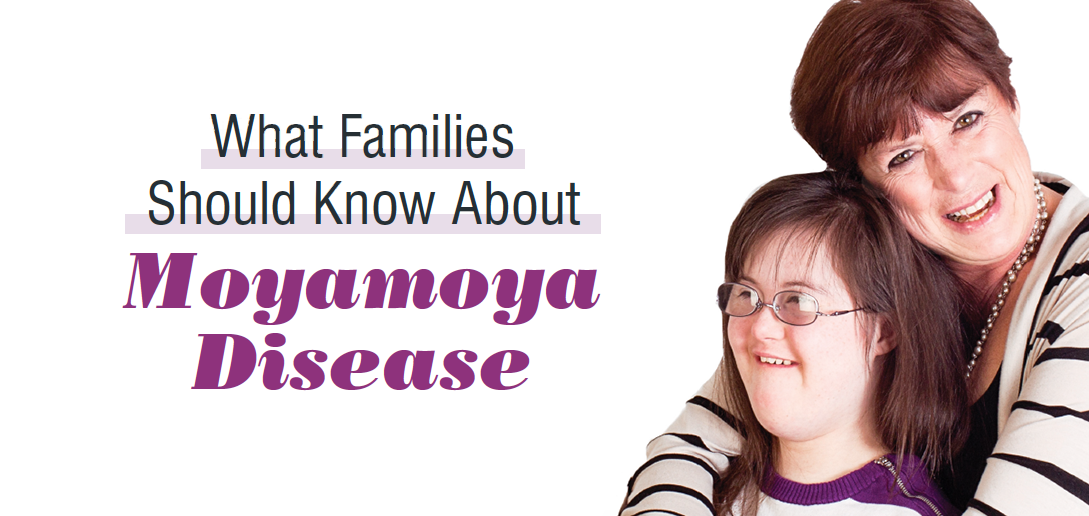
Maria Dellapina and her daughter, Erin Farragher
From Down Syndrome WorldTM Issue 1 2019
This rare disease is significantly more common in children with Down syndrome. Understanding symptoms and early detection could save a life.
“WHAT IS MOYAMOYA DISEASE?” many readers may be asking themselves. It is a rare blood vessel disease caused by blocked arteries in the brain. The name “moyamoya” is derived from a Japanese term meaning “puff of smoke,” because the tangle of vessels often resembles a small puff of smoke. Occurring in approximately 1 out of every 100,000 people, moyamoya disease can be fatal if left undiagnosed and untreated. It is estimated that people with Down syndrome are 26 times more likely to develop the disease, compared with the typical population. It is important for parents of children with Down syndrome to know the warning signs and next steps if their child is diagnosed.
A MOTHER’S STORY
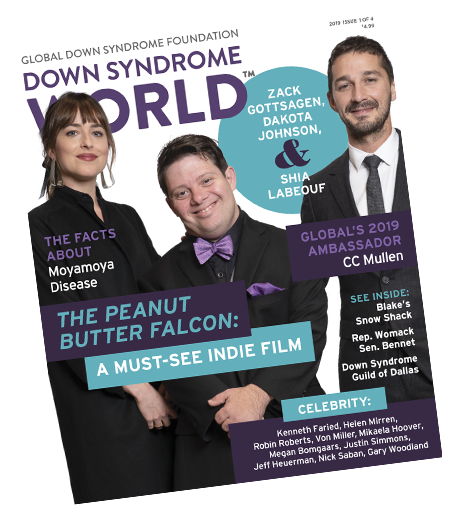 This article was published in the award-winning Down Syndrome World™ magazine. Become a member to read all the articles and get future issues delivered to your door!
This article was published in the award-winning Down Syndrome World™ magazine. Become a member to read all the articles and get future issues delivered to your door! Maria Dellapina, from Burton, Ohio, is the founder of the award-winning adaptive eyewear company, Specs4Us. Her daughter, Erin Farragher, happens to have Down syndrome. When Erin was 16 years old, she began experiencing unusual symptoms of shaking , fainting, and muscle aches.
“Erin called out to me, I turned around, and she was shaking all over and fell to the ground,” recalls Dellapina. Initially, Dellapina thought her daughter had experienced a mini-stroke, but Erin bounced back quickly.
However, Erin’s symptoms continued to occur — more headaches, more muscle aches, and poor balance. In Dellapina’s search for answers, she received an email from a parent, who, based on his experience with his daughter, advised Dellapina to look into moyamoya disease, a term with which she was unfamiliar.
Growing increasingly concerned with Erin’s “off” behavior over the next few days, Dellapina decided to take Erin to the emergency department at a local hospital.
“When I pulled into the parking lot, Erin star ted throwing up,” Dellapina recalls. “The physicians thought Erin had the flu. They even laughed when I mentioned moyamoya.”
Not convinced, Dellapina took Erin to another hospital in Cleveland. A CT scan revealed Erin had suffered from a stroke. In fact, it was just one of several strokes and transient ischemic attacks (TIAs), also called “mini-strokes,” that Erin had apparently experienced throughout her young life. Later, at Cleveland Clinic, an MRI and angiogram led physicians to diagnose Erin with moyamoya disease.
LEARNING ABOUT MOYAMOYA
Anytime families receive an unexpected diagnosis, it can be very overwhelming and scary. Knowing the facts and what to expect can help ease some of that fear. Moyamoya disease occurs when the internal carotid arteries at the front of the neck that supply the brain with oxygenated blood gradually narrow, says Raphael Sacho, M.D., F.R.C.S., Assistant Professor of Neurosurgery at the Medical College of Wisconsin. As those vessels narrow, the two vertebral arteries at the back of the neck compensate by developing small blood vessels called collaterals. This causes a tangling of blood vessels in the brain, restricting blood flow.
“Collaterals take over the function of the internal carotid arteries over time,” Dr. Sacho explains. “That, in itself, can cause problems because the collaterals can be small, thin, and not used to taking so much blood. They can burst and cause bleeding.”
As a result, many people with moyamoya disease experience strokes, just as Erin did. All types of strokes share symptoms such as headaches, seizures, visual disturbances, one-sided weakness, slurred speech, involuntary movements, and cognitive impairment. Some common strokes that occur with people who have moyamoya disease are TIAs, ischemic strokes, and hemorrhagic strokes. TIAs occur when blood flow to the brain is interrupted briefly but then resumes, which is why they are often called “mini-strokes.” Ischemic strokes occur as a result of a blood clot completely blocking an artery that supplies the brain with blood. Hemorrhagic strokes — major brain bleeds — may occur if blood vessels or collaterals burst.
The reason people with or without Down syndrome develop moyamoya disease is unclear.
It’s thought that genetics may play a role, as several mutations to the gene RNF213 are associated with moyamoya disease. Infection or inflammation may also be involved in its development, according to the National Institutes of Health (NIH).
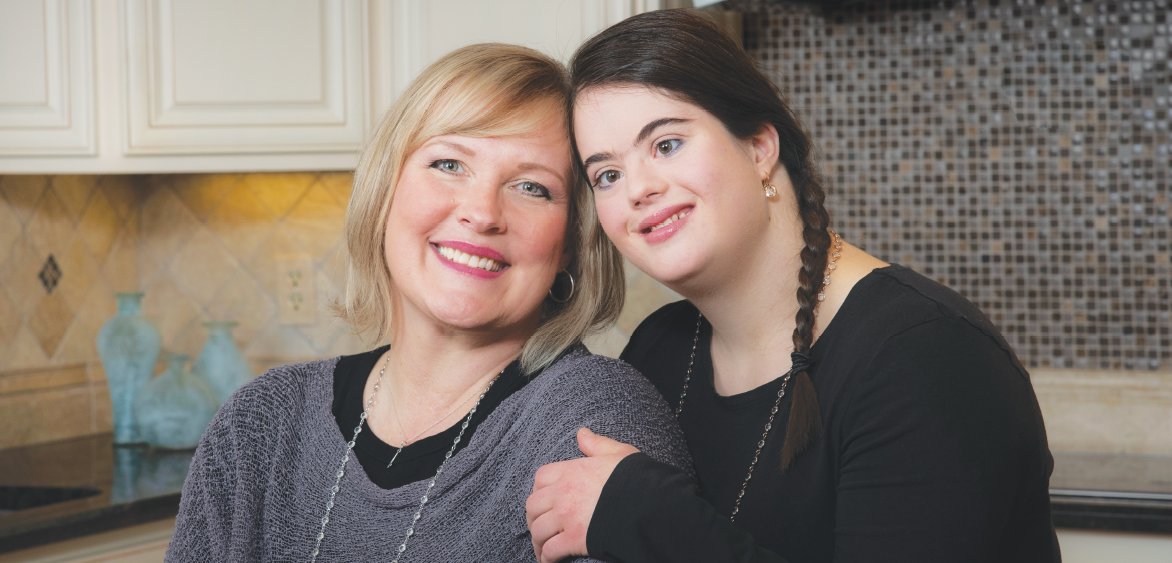
Mary Beth Freckmann and her daughter, Madie Ehlers
PREVALENCE AND THE IMPORTANCE OF EARLY DETECTION
“In the United States, it was thought moyamoya disease occurred in 0.1 per 100,000 people,” says Gary Steinberg, M.D., Ph.D., Chair of Neurosurgery, Director of the Stanford Moyamoya Center, and Founder and Co-Director of the Stanford Stroke Center. “More recent studies have shown the incidence may be 0.5 or closer to 1 per 100,000 because it’s been under-recognized in the U.S.”
While the disease is rare in the general population, people with Down syndrome are 26 times more likely to develop the disease than typical people, according to Dr. Sacho. The reasons for that discrepancy are also unclear, though signs seem to point to genetics. He adds that, in Down syndrome, there’s something about the triplication of chromosome 21 (the defining characteristic of Down syndrome) that predisposes this population to moyamoya disease.
The disease can be more difficult to detect in children with Down syndrome than typical children, which may explain why, on average, children with Down syndrome are diagnosed with moyamoya disease nearly two years later than typical children. According to a 2015 study by researchers at Boston Children’s Hospital, children with Down syndrome are usually diagnosed at age 8.4 versus 6.5 for typical children.
A delayed diagnosis can allow moyamoya disease to progress to a more advanced stage.
Dellapina believes an early diagnosis likely would have made a significant difference for her daughter, who, she now believes, showed signs of TIAs as early as age 11. In 2016, Erin underwent pial synangiosis surgery — the typical treatment for moyamoya disease. The procedure involves surgeons creating new blood vessels to supply the brain. It’s believed these new blood vessels can do the job better and have a lower risk of bursting than the collaterals. Once the new vessels are functional, patients both with and without Down syndrome enjoy a normal life expectancy, Dr. Steinberg says.
“That is why it’s so important to diagnose and treat promptly,” he says.
Unfortunately, strokes and TIAs had already significantly damaged Erin’s brain by the time she had surgery, which did not succeed in ending the strokes and seizures. Now 19, she receives hospice care while Dellapina focuses on giving her the best quality of life possible.
For 25-year-old Madie Ehlers of Wisconsin, treatment has, so far, been successful. Born with Down syndrome, she was diagnosed with moyamoya disease in late 2013 at age 20. Like Erin, Madie experienced fleeting stroke-like symptoms and was initially misdiagnosed. She has had three surgeries since spring 2014 — two on the left side of her brain and one on the right, and her symptoms have disappeared.
Today, Madie is back to being active in her community. She is training to become a certified Zumba instructor and plans to marry her boyfriend next year.
“Madie hasn’t had any symptoms since two weeks after her most recent surgery in October 2018,” says Madie’s mother, Mary Beth Freckmann. “Dr. Sacho [who performed the surgery] really believes this will give her a very long life.”
Like this article? Join Global Down Syndrome Foundation’s Membership program today to receive 4 issues of the quarterly award-winning publication, plus access to 4 seasonal educational Webinar Series, and eligibility to apply for Global’s Employment and Educational Grants.
Register today at downsyndromeworld.org!
The Peanut Butter Falcon: A Must-See Indie Film Starring Zack Gottsagen
May 19th, 2019 by Global Down Syndrome Foundation
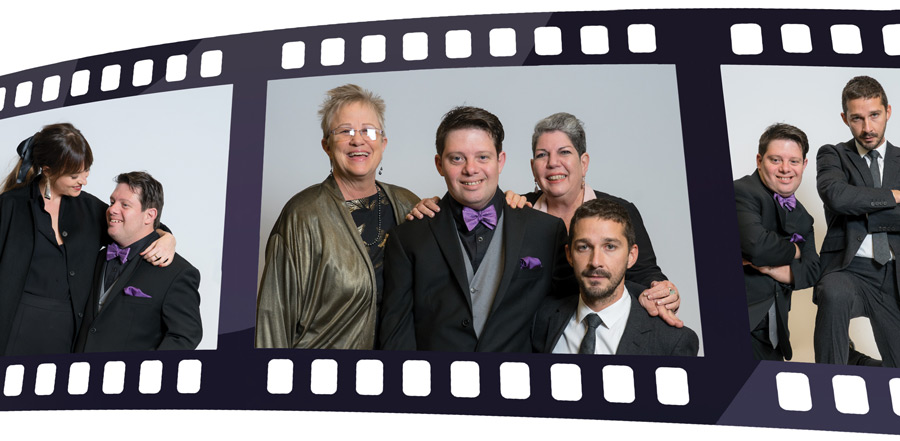
Featured: Dakota Johnson, Zack Gottsagen, and his mothers, Shelley and Trish, and Shia LaBeouf at Global’s Be Beautiful Be Yourself Fashion Show. Photos: Jared Wilson
From Down Syndrome WorldTM Issue 1 2019
Film wins Audience Award at the prestigious South By Southwest (SXSW) Film Festival, and audiences fall in love with Global Down Syndrome Foundation’s Q-Award winner. The key to the movie’s success? Friendship.
ZACK GOTTSAGEN IS NO STRANGER to the spotlight — in fact, he dances right into it. Last year, Gottsagen received the Global Down Syndrome Foundation Quincy Jones Exceptional Advocacy Award. After giving a powerful acceptance speech, he literally threw off his jacket and unexpectedly danced down the runway, charming a crowd of over 1,400 guests at Global’s 10th Anniversary Be Beautiful Be Yourself Fashion Show.
The accomplished actor, who is 33 years old and happens to have Down syndrome, stars alongside Shia LaBeouf and Dakota Johnson in a new feature-length indie film called The Peanut Butter Falcon. Gottsagen’s breakout role and the film were praised by Variety magazine’s review: “… there’s something so guileless and genuine about Zak (qualities that stem directly from the actor playing him) that he manages to win over both his newfound friend and the audience in the same coup.”
The review goes on to focus on the relationship between LaBeouf’s and Gottsagen’s characters. “… Both [their acting] approaches result in a kind of spontaneous unpredictability, making the characters’ choices feel constantly surprising.” Definitely two thumbs-up!
The Peanut Butter Falcon tells the story of a young man with Down syndrome, Zak (Gottsagen), who escapes from the nursing home where he pines to follow his dream of becoming a professional wrestler. Along the way, he meets Tyler (LaBeouf), a troubled traveler with a mysterious past, and Eleanor (Johnson) who is sent from the nursing home with orders to return Zak to the facility. The film also includes award-winning actors Thomas Haden Church, who plays a retired wrestler, and Bruce Dern, Zak’s roommate who helps him escape from the nursing home.
In March, Gottsagen and LaBeouf promoted the film together at the prestigious SXSW Film Festival in Austin, Texas, where The Peanut Butter Falcon won the “Narrative Spotlight” Audience Award.
The filmmakers are hoping to land a distribution deal and release by summer of 2019.
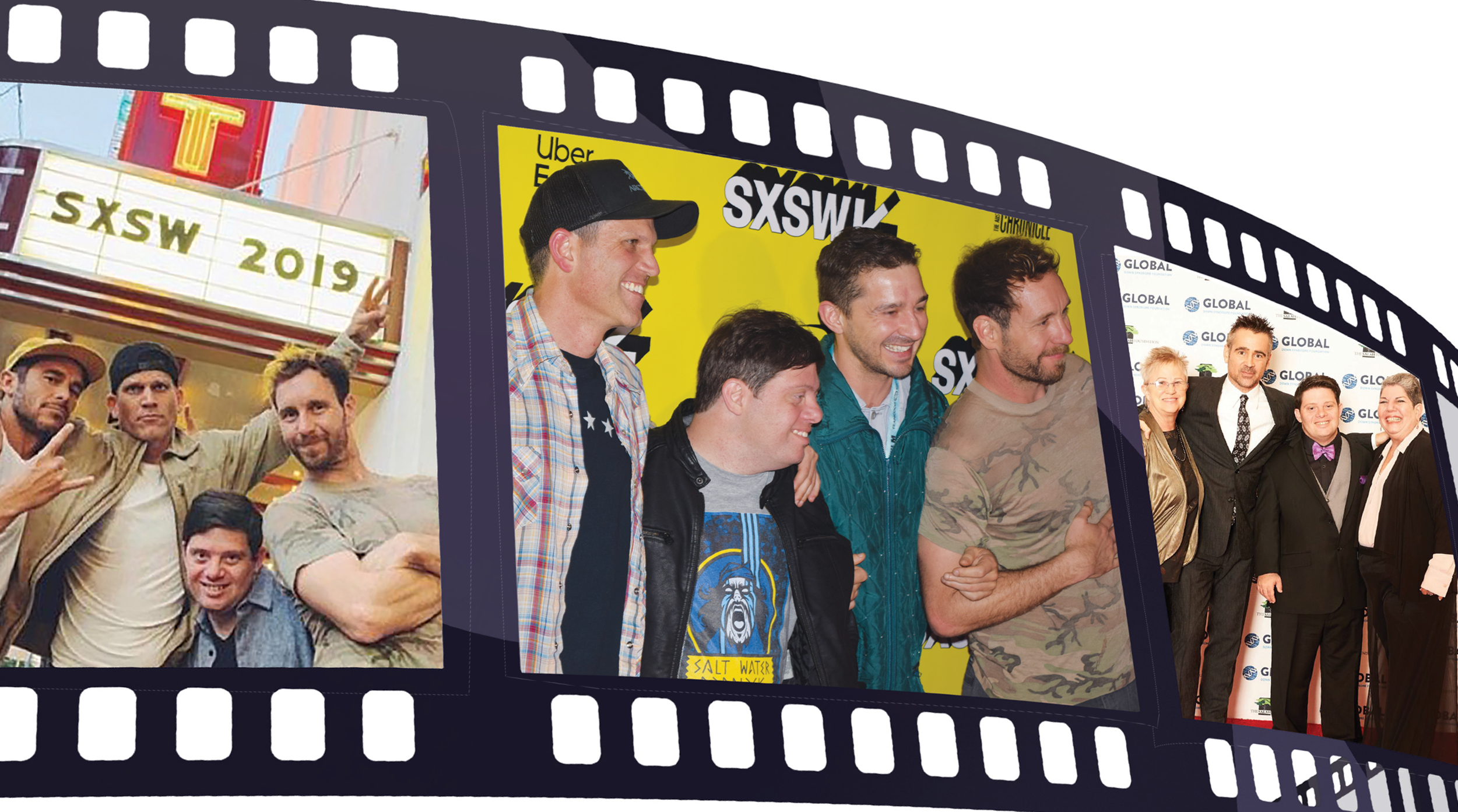
The Peanut Butter Falcon crew at the 2019 SXSW Film Festival. Global’s Q-Award winners Colin Farrell and Zack Gottsagen strike a pose with Gottsagen’s moms, Shelley and Trish.
DESTINED TO BE AN ACTOR
Gottsagen was born with an irresistible charm and drive to change the world. Just ask his mom Shelley Gottsagen.
“Zack has this ability to connect with people from all walks of life,” she says. “He has a real compassion and love for people.”
He was also born with the rare vigor and determination necessary to succeed in the entertainment business.
“Zack tells everyone he meets about his passion for acting , which landed him a lead role in a feature film,” she adds.
“I have wanted to be an actor since I was 3 years old,” Zack says. “I want to show people that no matter who you are, if you follow your heart, you can do whatever you want with your life.”
It was this charisma and determination that led to Gottsagen being cast as one of the first actors with Down syndrome to star as the lead in a full-length feature film. Co-writers and directors, Tyler Nilson and Michael Schwartz, explained their inspiration to write The Peanut Butter Falcon.
“Zack told Michael and me that we should write a movie for him to star in,” Nilson says. “We thought it was genius!”
Nilson and Schwartz had worked with Gottsagan on other short films at Zeno Mountain Farm, a nonprofit that hosts inclusive camps in Vermont, California, and Florida for people of all abilities . They were taken not only by his acting ability but his uncanny sense of timing and skill at reading others. But how to capture that on screen?
Schwartz continues, “Being friends with Zack for many years, we tried to create the most authentic experience we could for our audience by writing a character that is really tailored to Zack and his strengths.”
Gottsagen’s character in The Peanut Butter Falcon, “Zak,” is consistent with Zack the actor in elements such as his love of wrestling and caring, determined spirit.
The result is truly a must-see movie. Variety likened it to indie great Little Miss Sunshine and blockbuster hit Forrest Gump, calling it “a feel-good niche indie with its priorities in the right place.”
GOTTSAGEN, LABEOUF, & JOHNSON ON-SCREEN CHEMISTRY
 This article was published in the award-winning Down Syndrome World™ magazine. Become a member to read all the articles and get future issues delivered to your door!
This article was published in the award-winning Down Syndrome World™ magazine. Become a member to read all the articles and get future issues delivered to your door! A huge part of any movie’s success is the on-screen chemistry of its actors. The Peanut Butter Falcon has this in spades because the actors became very close while filming. And they have remained close — supporting each other at award ceremonies and keeping in touch frequently through text messages and phone calls.
The bonding happened remarkably fast. Once Nilson and Schwartz finalized the script, the crew had only 30 days to film on the isolated beaches of Savannah, Georgia. Being together every day for a month and working through late hours of the night, the cast truly became a family. Every morning before they started shooting, Gottsagan would give the team a pep talk.
Gottsagen’s mom, Shelley, recalls, “He would call out certain members of the group and thank them for what they did that day. It really gave everyone that extra boost of confidence and created a sense of community.”
For LaBeouf and Gottsagen, their relationship began before the two ever met.
“I saw a video of Zack and thought it would be incredible to work with him. I fell in love with him before I even met him,” LaBeouf explains.
LaBeouf, Johnson, and Gottsagen would eat lunch together every day during filming. Gottsagen consistently ate only chicken. Johnson even named her rescue cat “Chicken” because she said it would make her think of Gottsagan when she was home. While LaBeouf and Gottsagen would watch wrestling together every Monday and Tuesday, Johnson would get mani/pedis with Gottsagen once a week.
“When I met Zack just before we started filming The Peanut Butter Falcon, I was totally bewildered by his purity of heart,” Johnson explains. “He is extremely intelligent, kind, charming, hilarious, and deeply empathetic. He’s the most loving and embracing person I’ve ever met in my life.”
IMPROV GOLD
It was important to the film’s stylistic integrity to keep everything as realistic as possible.
“Zack insisted that he do all of his own stunts,” Shelley recalls. “I couldn’t believe that he jumped off the wooden bridge into the water or that he grabbed a fish with his bare hand! But he wanted it to be real.” She explained how this process wouldn’t have been possible without Nilson and Schwartz’s imaginative vision.
“They allowed Zack to have creative control with his scenes, which really made a difference in bringing his character to life.”
“Often, what Zack and Shia came up with was even better than what was on the page,” Nilson says. “Some of the funniest lines and bits in the film, I have to admit, actually come from Zack’s improv!”
Schwartz adds, “With Zack and Shia, we created a space for them to actually live the scenes.”
LaBeouf confirms how special the interaction was. “When Zack and I met, we would just start riffing with each other [while filming],” he says. “Everywhere it went, we’d wind up with gold. We had really deep conversations that I could only have with Zack.”
Gottsagen agrees. “We practiced our lines, but we were able to make it real, and that’s what it’s all about.”
During red carpet interviews at SXSW, the whole cast and crew spoke to the understanding, patience, and appreciation they developed for people with Down syndrome by working with and learning from Gottsagen.
Schwartz summed it up. “There’s a magic that Zack brings to every scene. With him, he’s not just saying his lines, he’s actually feeling the moment.”
AN IMPORTANT ROLE MODEL, AN IMPORTANT FILM
Gottsagen caught Global’s attention when a Global Ambassador, Chase Turner Perry, identified a family connection to a producer of The Peanut Butter Falcon.
“We were actually a little nervous as we can’t support a film, even a great film, if the messaging is counter to our advocacy work,” says Michelle Sie Whitten, President and CEO of Global. “So we organized a screening in Denver last May, and I was blown away by how excellent the film is, how it pulls you in, and how the film makes important societal statements that the Down syndrome community would be proud of.”
After spending a good amount of time with Gottsagen, Whitten and her team made the decision to honor Gottsagen with Global’s 2018 Quincy Jones Exceptional Advocacy Award at their 10th Anniversary Be Beautiful Be Yourself Fashion Show, the largest fundraiser for people with Down syndrome in the world.
“Zack is a role model and inspiration not just for people with Down syndrome, but for all of us,” says Whitten.
To Whitten’s surprise, The Peanut Butter Falcon family immediately rallied, and LaBeouf, Johnson, Nilson, Schwartz, and other crew members descended upon Denver to support Gottsagen. LaBeouf and Johnson both introduced Gottsagen and helped bestow the Global award.
Now Global is part of the family supporting Gottsagen and traveled to Austin to cover him and The Peanut Butter Falcon at SXSW. Johnson was not able to attend but sent her best wishes to Gottsagen via text. LaBeouf and Gottsagen walked the red carpet together, laughing, joking, and posing for photos.
During the screening, the audience laughed and cried. When the credits started to roll, there was a standing ovation. At the end of the Q&A that followed, Gottsagen took the microphone.
“I make Shia’s life better every day,” he told the SXSW audience. LaBeouf laughed and nodded in agreement. The sincere and unique friendship, both on and off the screen, is undeniable.
Like this article? Join Global Down Syndrome Foundation’s Membership program today to receive 4 issues of the quarterly award-winning publication, plus access to 4 seasonal educational Webinar Series, and eligibility to apply for Global’s Employment and Educational Grants.
Register today at downsyndromeworld.org!
Down Syndrome Research Could Provide Important Insights Into Cancer Treatments
March 8th, 2019 by Global Down Syndrome Foundation
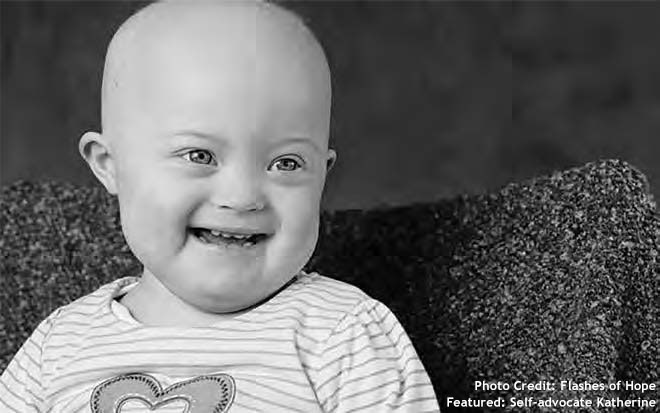
From Down Syndrome World Issue 4 2018
People with Down syndrome are highly protected from most solid tumor cancers, and yet they are highly predisposed to certain blood cancers. Studying people with Down syndrome may lead to new cancer treatments that could benefit everyone.
ACCORDING TO THE AMERICAN CANCER SOCIETY, an estimated 1,762,450 new cases of cancer will be diagnosed in 2019. There are hundreds of types of cancers and different ways to categorize them. One way to categorize cancer is into two types — solid tumor cancers and blood, or hematological, cancers.
People with Down syndrome are highly protected from most solid tumor cancers, such as breast, uterine, and prostate cancers. However, people with Down syndrome are much more likely to develop certain leukemias, one of the key blood cancers found predominantly in children.
IN SEARCH OF ANSWERS
World-renowned cancer researcher Joaquín Espinosa, Ph.D., Executive Director of the Linda Crnic Institute for Down Syndrome, has studied cancer biology for years. He was an early career scientist of the Howard Hughes Medical Institute before a grant from the Global Down Syndrome Foundation opened his eyes to the broad implications of investigating the connection between cancer and Down syndrome.
“My mentor, Tom Blumenthal, was the director of the Crnic Institute and insisted I apply for a grant,” says Dr. Espinosa. “I had no idea that the science would be so fascinating and that I would come to feel that people with Down syndrome are like my extended family.”
Three years later, Dr. Espinosa and his team discovered that the extra copy of chromosome 21 in people with Down syndrome triggers an immune system process called the interferon response, which may have a significant bearing on cancer risk.
“From birth, the immune system of people with Down syndrome is very dysregulated,” Dr. Espinosa says. “It’s out of balance, so aspects of it are hyperactive and others are weakened. The hyperactivity may explain why solid tumor cancers are not allowed to grow and, therefore, why it is rare for people with Down syndrome to get most solid tumor cancers. Conversely, it may also explain why autoimmune disorders are so prevalent.”
Other researchers hypothesize that chromosome 21 contains one or more tumor-suppressing genes, which may explain why having an extra copy of the chromosome protects against solid tumors, and that the chromosome also contains genes that spur the development of leukemias.
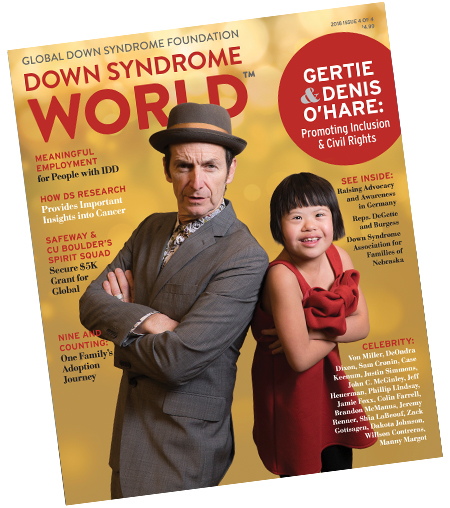 This article was published in the award-winning Down Syndrome World™ magazine. Become a member to read all the articles and get future issues delivered to your door!
This article was published in the award-winning Down Syndrome World™ magazine. Become a member to read all the articles and get future issues delivered to your door!
LUKEMIA: AN EARLY CHILDHOOD RISK
Children with Down syndrome are particularly susceptible to two types of leukemia: acute megakaryoblastic leukemia (AMKL) and B-cell acute lymphoblastic leukemia (B ALL), the most common subtype of acute lymphoblastic leukemia (ALL).
They are also uniquely susceptible to one bone marrow disorder that results in a higher risk of AMKL called transient myeloproliferative disorder (TMD). TMD, also called transient leukemia, is found only in newborns with Down syndrome. As many as 30 percent of babies with Down syndrome are born with TMD, and although it can cause severe or life-threatening problems, the overwhelming majority of cases resolve naturally by the third month of life.
However, infants with TMD are at increased risk of developing acute myeloid leukemia (AML), which can strike children all the way through the teenage years. In particular, children with Down syndrome between ages 1 and 5 are 150 times more likely than typical children to develop AMKL, a rare type of AML. AMKL is a life threatening leukemia in which malignant megakaryoblasts proliferate abnormally and injure various tissues.
While the risk for AMKL is consider ably higher, many studies report better outcomes for patients with Down syndrome compared with their typical counterparts. Children with Down syndrome who develop AMKL have a roughly 80 percent five year event-free survival rate, which is substantially better than that seen in typical children with this leukemia, according toJohn Crispino, Ph.D., Robert I. Lurie, M.D. and Lora S. Lurie Professor of Medicine at Northwestern University.
“Nevertheless, not all children with Down syndrome survive the disease, and survival rates for those who relapse even after a bone marrow transplant are abysmal,” Dr. Crispino says.
Dr. Crispino’s lab has several areas of focus including acute leukemias and myeloproliferative neoplasms, and he is considered one of the leading authorities regarding leukemia in patients with Down syndrome.
According to Dr. Crispino, there is a 20-fold increased risk of B-ALL in children and young adults with Down syndrome primarily from ages 5 to 20. B-ALL is an aggressive type of leukemia in which too many B-cell lymphoblasts are found in the bone marrow and blood.
Unlike AMKL, reports and studies show that patients with Down syndrome with B-ALL fair worse than their typical counterparts — they have a higher relapse rate, may suffer severe side effects from chemotherapy, and have higher treatment-related mortality.
According to Dr. Crispino, part of the problem could be attributed to the attending physicians’ lack of adherence to the different chemotherapy protocols for pediatric patients with Down syndrome. Patients with Down syndrome often react poorly to standard chemotherapy for B-ALL, and their “toxicity profile” means more side effects that can result in extreme loss of red and white blood cells and platelets, inflammation in the digestive tract, and even heart failure.
“These patients need modified treatment protocols and universal supportive care guidelines that are optimal,” says Dr. Crispino. “Including patients with Down syndrome in studies of novel agents, such as immunotherapy and JAK inhibitors, could also help address this problem.”
Global’s lobbying and advocacy effor ts, resulting in a $24 million increase in Down syndrome research at the National Institutes of Health (NIH) in 2018, certainly led to an increase in cancer research in this special population, but there is still a long w ay to go. Dr. Crispino believes we desperately need less toxic and more effective therapies, especially to prevent relapse and treatment related mortality in patients with Down syndrome. He advocates for research at the NIH that would determine why Down syndrome leads to the increased incidence of leukemia and identify novel drug targets that will lead to development of safer treatments, and for leveraging new technologies that will identify specific genes on chromosome 21 linked to leukemia.
While leukemia does not always cause symptoms, Karen Rabin, M.D., Ph.D., Associate Professor of Pediatric Hematology/Oncology and Director of the Leukemia Program at Texas Children’s Cancer Center and Baylor College of Medicine, says parents should look out for bone pain, difficult y walking, easy bruising or bleeding, pallor, prolonged and unexplained fevers, and swollen glands in the neck and elsewhere.
A complete blood count can detect leukemia in some cases but is not recommended unless symptoms are present, according to Dr. Rabin. Chemotherapy is the standard treatment for most acute leukemia. But immunotherapy — a class of therapies that train the immune system to target cancer — is an emerging option.
“Immunotherapy is not generally used for newly diagnosed ALL at this time, but it is a very effective treatment in cases of relapse,” Dr. Rabin explains. “I particularly recommend early consideration of immunotherapy for relapsed ALL in children with Down syndrome because they are at high risk of serious complications when treated with standard relapse chemotherapy regimens.”
RESEARCH THAT BENEFITS EVERYONE
Of the 1.7 million new cancer cases estimated to be diagnosed in the United States in 2019, it is impossible to know how many of those cancers will occur in people with Down syndrome, according to Dr. Espinosa. Regardless, studying cancer in this population benefits anyone who develops the disease. Dr. Rabin agrees.
“We first discovered a major class of genetic alterations in ALL by studying ALL samples from children with Down syndrome, where the alterations are much more common than in other ALL cases,” she says. “This has led to a clinical trial of ruxolitinib, an inhibitor targeting this pathway, as a new treatment for ALL.”
Dr. Espinosa and his team at the Crnic Institute, with financial support from Global’s Mary Miller & Charlotte Fonfara-LaRose Down Syndrome & Leukemia Research Fund, are testing the effectiveness of drugs that inhibit two genetic mutations that cause runaway cellular growth linked to leukemia. Dr. Crispino and his team have conducted preclinical studies of inhibitors of a particular gene on chromosome 21 that may be active both in individuals with Down syndrome who have B-ALL and in some typical individuals with that type of leukemia.
“With respect to solid tumors, research into why people with Down syndrome develop cancer at low rates has enormous potential to shed light on chemoprevention strategies,” Dr. Crispino states. “If we can discover the genes on chromosome 21 that protect against solid tumors, we may be able to leverage these insights to develop drugs to halt cancer initiation or progression in all people.”
Like this article? Join Global Down Syndrome Foundation’s Membership program today to receive 4 issues of the quarterly award-winning publication, plus access to 4 seasonal educational Webinar Series, and eligibility to apply for Global’s Employment and Educational Grants.
Register today at downsyndromeworld.org!
A Peanut Butter Falcon Takes Flight
December 21st, 2018 by Global Down Syndrome Foundation

From Down Syndrome World Issue 3 2018
ZACHARY “ZACK” GOTTSAGEN, an accomplished stage performer and film actor who happens to have Down syndrome, was working on set for a movie in Los Angeles courtesy of the amazing nonprofit, Zeno Mountain Farm, when he met directors Tyler Nilson and Michael Schwartz. They were so taken with Zack’s intelligence, humor, enthusiasm, and joy for life that they decided to write a film for him to star in. The result, The Peanut Butter Falcon, incorporates Zack’s infectious personality and his love for wrestling into their lead character, also named Zak. The two relatively new directors gained the support of big-name actors including Shia LaBeouf, Dakota Johnson, and Thomas Haden Church.
Nilson and Schwartz hope The Peanut Butter Falcon, their first feature-length movie, gives people who are differently-abled a taste of the freedom they can enjoy when they follow their dreams.
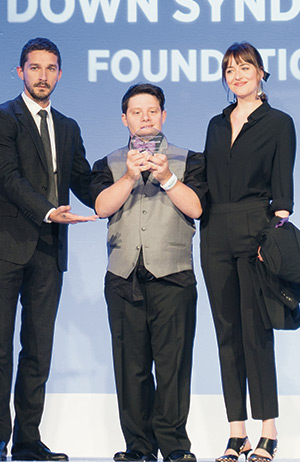 A modern-day spin on Huckleberry Finn, The Peanut Butter Falcon follows Zak, a 22-year-old man with Down syndrome, who escapes the nursing home where he lives to pursue his ambition of professional wrestling. The budding wrestler hopes to meet retired wrestling legend “The Salt Water Redneck,” played by Thomas Haden Church, who lives in rural North Carolina. On his journey, Zak meets a crab fisherman and small-time outlaw named Tyler (played by LaBeouf), who becomes Zak’s ally.
A modern-day spin on Huckleberry Finn, The Peanut Butter Falcon follows Zak, a 22-year-old man with Down syndrome, who escapes the nursing home where he lives to pursue his ambition of professional wrestling. The budding wrestler hopes to meet retired wrestling legend “The Salt Water Redneck,” played by Thomas Haden Church, who lives in rural North Carolina. On his journey, Zak meets a crab fisherman and small-time outlaw named Tyler (played by LaBeouf), who becomes Zak’s ally.
Lucky Treehouse, one of the film’s production companies, describes the pair’s adventure: “Together they wind through deltas, elude capture, drink whiskey, find God, [and] catch fish.” Tyler and Zak are eventually joined by Eleanor (played by Johnson), an employee from Zak’s nursing home who is searching for him as well as answers of her own.
“Many people struggle to maintain a regular life, not because of their disabilities, but because of others’ disbelief in their talents … I am making [this film] for the people who believe it is OK to dismiss them,” Nilson writes on Lucky Treehouse’s production website.
AN A-LIST CAST Gottsagen was excited to work alongside the Hollywood A-list actors. LaBeouf is known for roles in movies such as Transformers, Holes, and Borg vs McEnroe. Johnson is known for films including How to be Single and for starring in the Fifty Shades of Grey franchise. Church has acted in TV shows and movies since 1980 and most recently played the lead in the HBO series Divorce.
Bruce Dern, a two-time Oscar nominee, plays Carl, Zak’s roommate at the nursing home. Producers for the movie include Ron Yerxa and Albert Berger, the talent behind Cold Mountain and Little Miss Sunshine. T Bone Burnett, the creative genius behind numerous award-winning film scores, produced the soundtrack.
In addition to Lucky Treehouse, the film was produced by Armory Films, Nut Bucket Films, and Tvacom Film and TV.
 This article was published in the award-winning Down Syndrome World™ magazine. Become a member to read all the articles and get future issues delivered to your door!
This article was published in the award-winning Down Syndrome World™ magazine. Become a member to read all the articles and get future issues delivered to your door!THE MAKING OF A FALCON Despite its impressive cast and crew, The Peanut Butter Falcon’s true star is Gottsagen, 33, who credits his first acting role as the star of a natural childbirth instructional video on April 22, 1985. He was the first student to be fully included in a Palm Beach County public school, and in 2004, he earned a theater degree from the A.W. Dreyfoos School of the Arts in West Palm Beach. Currently, Gottsagen lives independently in Boynton Beach, Florida, and works at a local movie theater.
For more than 10 years, Gottsagen worked with Zeno Mountain Farm, a nonprofit that hosts camps for people of all abilities in Vermont, California, and Florida. He worked with the nonprofit’s Film Camp and appeared in movies such as Burning Like a Fire and Life of a Dollar Bill. While filming a western called Bulletproof, he got involved with a documentary titled Becoming Bulletproof, which followed the movie’s actors and probed the question of why more actors who are differently-abled don’t appear in films. The movie was nominated at numerous film festivals and won the Best Film, Audience Choice, Festival Prize, Grand Jury, and Best Documentary awards at the Cleveland International Film Festival, Heartland Film Festival, Massachusetts International Film Festival, New Hampshire Film Festival, and the Vail Film Festival respectively. It was screened at the Smithsonian Museum’s 25th anniversary of the Americans with Disabilities Act in July 2015 — Gottsagen was the keynote speaker at the event.
But it gets even better. In a March 2018 Esquire cover story interview, LaBeouf gave Gottsagen some serious credit for sobering up. In the cover story, LeBeouf not only alludes to Gottsagen’s acting chops, he states, “That mother#>@%&* is magical.”
For Gottsagen, he is centered knowing he has an extended family of actors and film crews. He appreciates the opportunity to live out his dream of being an actor and has already started on two additional productions.
“I hope that thousands of fans see [The Peanut Butter Falcon],” Gottsagen told the Palm Beach Post. “I hope that they will love it, and the cast, a lot, including myself.”
In May, the Global Down Syndrome Foundation hosted a special screening of The Peanut Butter Falcon at the Sie FilmCenter in Denver. It was attended by a focus group of local self-advocates and families, as well as Gottsagen and his mother, Shelley, who flew in from Florida.
Shelley is an extremely articulate but quiet woman who clearly has a remarkable relationship with her son. While she is awed by how outgoing her son is, she is not surprised at his career choice.
“Zack told me when he was 3 years old, and every year after that, he was going to be an actor,” she told the audience. “I am definitely proud at what he has accomplished.”
Gottsagen, music and film producer Berger, and director Schwartz did a Q&A after the screening, and the audience left inspired and thoroughly entertained. The film is currently in post-production and will be released later this year.
Gottsagen’s talent and his many accomplishments have earned him Global’s 2018 Quincy Jones Exceptional Advocacy Award along with award-winning Irish actor, Colin Farrell. The award will be presented at Global’s 10th Anniversary Be Beautiful Be Yourself Fashion Show, scheduled for Saturday, Oct. 20, in Denver.
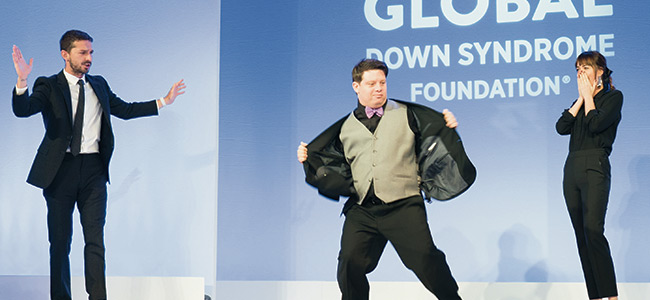
Like this article? Join Global Down Syndrome Foundation’s Membership program today to receive 4 issues of the quarterly award-winning publication, plus access to 4 seasonal educational Webinar Series, and eligibility to apply for Global’s Employment and Educational Grants.
Register today at downsyndromeworld.org!
Pioneering Care for People with Down Syndrome
November 8th, 2018 by Global Down Syndrome Foundation
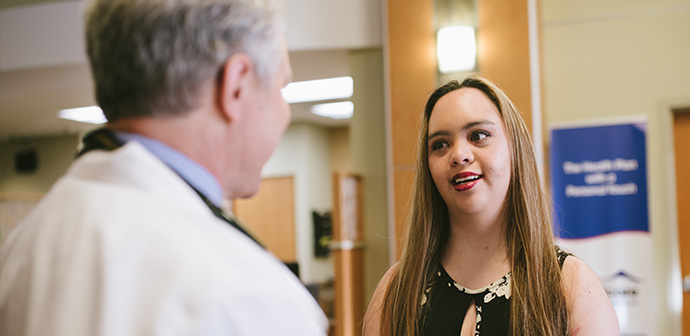
From Down Syndrome World Issue 3 2018
As one of the lead authors of the Medical Care Guidelines for Adults with Down Syndrome, George T. Capone, M.D., is continuing his life’s work of improving evidence-based medical care for people with Down syndrome.
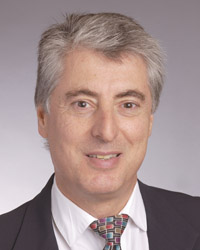 FOR THE PAST 30 YEARS, George T. Capone, M.D., has specialized in providing quality care for patients with Down syndrome, always pushing for better evidence-based treatment and interventions. As a research scientist, Director of the Kennedy Krieger Institute’s Down Syndrome Clinic and Research Center (DSCRC), and Associate Professor of Pediatrics at the Johns Hopkins University School of Medicine, he has seen more than 2,500 patients, ranging in age from infants to seniors. Dr. Capone has contributed to improved care since the 1980s, and he continues to be concerned about health care for adults with Down syndrome.
FOR THE PAST 30 YEARS, George T. Capone, M.D., has specialized in providing quality care for patients with Down syndrome, always pushing for better evidence-based treatment and interventions. As a research scientist, Director of the Kennedy Krieger Institute’s Down Syndrome Clinic and Research Center (DSCRC), and Associate Professor of Pediatrics at the Johns Hopkins University School of Medicine, he has seen more than 2,500 patients, ranging in age from infants to seniors. Dr. Capone has contributed to improved care since the 1980s, and he continues to be concerned about health care for adults with Down syndrome.
Dr. Capone’s extensive knowledge, experience, and passion to improve care are the primary reasons he was tapped to join a team of physicians and researchers updating the Medical Care Guidelines for Adults with Down Syndrome, a project funded by the Global Down Syndrome Foundation.
AN EARLY SUPPORTER OF TRANSLATIONAL RESEARCH
Dr. Capone’s career treating people with Down syndrome took root in 1988, when he began a neurobiology fellowship at Johns Hopkins University School of Medicine. At the time, researchers at Johns Hopkins, including his mentor Joseph T. Coyle, M.D., were conducting groundbreaking genetic research on the link between Down syndrome and Alzheimer’s disease. Among the many projects he saw occurring in Dr. Coyle’s lab was research that used TS16 mouse models to investigate the impact that three copies of chromosome 21 — the defining characteristic of Down syndrome — has on early-onset Alzheimer’s disease. It was some of the earliest research on the subject.
 This article was published in the award-winning Down Syndrome World™ magazine. Become a member to read all the articles and get future issues delivered to your door!
This article was published in the award-winning Down Syndrome World™ magazine. Become a member to read all the articles and get future issues delivered to your door!The time spent in Dr. Coyle’s lab helped lay the foundation for Dr. Capone’s interest in how that research could be directly applied to the health and well-being of patients. In the early 1990s, Dr. Capone joined the Kennedy Krieger Institute. There, he recognized that the DSCRC provided ample opportunity to develop hypotheses and research questions on the neurobiological and neurobehavioral basis of cognitive impairment associated with Down syndrome. The clinic’s diverse patient population allowed for “person-centered clinical research focusing on the medical and mental health conditions we see on a daily basis.” Such research, he knew, would benefit not only people with Down syndrome but also patients with its co-occurring conditions, such as Alzheimer’s disease, sleep apnea, and heart conditions.
Under Dr. Capone’s leadership, the DSCRC has conducted studies on a range of conditions, including autism-spectrum disorders and attention-deficit/hyperactivity disorder. His research has led to the characterization of autism in children with Down syndrome, uncommon neurobehavioral and developmental profiles of children and teenagers with Down syndrome, and developmental regression in people of all ages with the condition.
He has also designed and conducted several clinical pharmacology trials for drugs intended to improve memory and cognition in both children and adults, including risperidone, guanfacine, and rivastigmine.
“The science is fascinating, and the associated medical conditions are complex and perplexing,” Dr. Capone said. “The families I work with are the best, and the children and adults I interact with always amaze me.”
FORGING NEW PATHS FOR ADULT MEDICAL CARE
Dr. Capone agrees that the increased knowledge and advocacy among parents and healthcare professionals, the establishment of specialized clinics such as the DSCRC, and advancements in medical-surgical care for children have all progressed health for people with Down syndrome. Yet, despite contributions to the field of care for people with Down syndrome, more research is necessary to improve lives.
“We need to better understand the etiology-pathogenesis and risk factors associated with certain medical conditions, as well as what treatment approaches and prevention strategies are most beneficial to our patients,” Dr. Capone explained. “We also need a more organized approach to managing data sets to improve clinical decision-making, patient and caretaker outcomes, and quality of life.”
The Medical Care Guidelines for Adults with Down Syndrome will go a long way toward improving clinical decision-making and health outcomes. The current guidelines available for adults with Down syndrome were last updated in 2001 and do not adequately reflect the more than doubling of life span for people with Down syndrome since the 1980s. As adults with Down syndrome are living longer, they require care specific to their unique aging experience and risk factors.
“Many physicians in adult medicine do not have adequate training to care for people with genetic and neurodevelopmental conditions,” Dr. Capone said. “The medical conditions experienced by adults with Down syndrome can appear overwhelming and beyond the reach of many physicians, but with sufficient resources and training, we can teach primary care and other adult healthcare providers how to provide this care with confidence.
“Coming up with medical care guidelines will expose how little we really know about ‘best practices’ when caring for aging adults with Down syndrome and chronic medical conditions,” he added. “I hope it will stimulate further interest and investigation into this often neglected aspect of clinical research.”
To learn more about the Medical Care Guidelines for Adults with Down Syndrome, please visit globaldownsyndrome.org/medical-care-guidelines.
ADVICE FOR FAMILIES AND SELF-ADVOCATES
George T. Capone, M.D., Director of the Down Syndrome Clinic and Research Center at Kennedy Krieger Institute and Associate Professor of Pediatrics at the Johns Hopkins University School of Medicine, has some advice, learned over a 30-year career, to pass along to people with Down syndrome and their families.
Don’t get caught up in comparisons.
“If your child seems different compared to other children you know with Down syndrome, don’t despair,” Dr. Capone said. “All our children are unique, and we should rejoice in these differences.”
Exercise body and mind.
“Stay physically and mentally active once you leave high school or post-secondary school,” he said. “Find your own means of self-expression through the performing arts, fitness, hobbies, and fun social activities.”
Connect.
“Stay informed and connected to the larger Down syndrome community of families and selfadvocates,” he advised.
Like this article? Join Global Down Syndrome Foundation’s Membership program today to receive 4 issues of the quarterly award-winning publication, plus access to 4 seasonal educational Webinar Series, and eligibility to apply for Global’s Employment and Educational Grants.
Register today at downsyndromeworld.org!
The Importance of Immune System Dysregulation in People with Down Syndrome
November 8th, 2018 by Global Down Syndrome Foundation
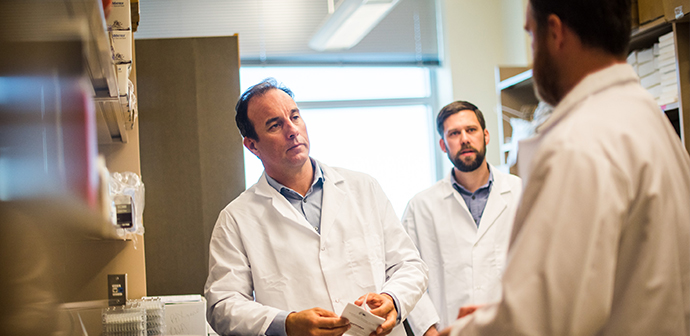
From Down Syndrome World Issue 3 2018
How does an extra copy of chromosome 21 drive the developmental and clinical features of Down syndrome? This question has been the subject of many investigations since 1958, when Jérôme Lejeune reported the Presence of trisomy 21 in cells of people with Down syndrome. The answer has remained elusive.
NOW, RESEARCH FROM the Linda Crnic Institute for Down Syndrome points to dysregulation of the immune system as a mechanism by which the extra chromosome would cause this multiorgan, multi-system condition. The implications of these results are profound, because they not only provide a new conceptual framework for future research, but also illuminate avenues for the development of novel diagnostic and therapeutic opportunities to improve health outcomes in Down syndrome. Of the more than 20,000 genes encoded in the human genome, chromosome 21 carries fewer than 300, the lowest number of genes on any human chromosome. While consensus among scientists is that Down syndrome is a “polygenic condition,” a condition caused by increased activity of more than one gene, it is also agreed that not all genes on chromosome 21 would contribute equally to the condition. If one were to select a random group of 300 genes, it is recognized that only a few genes would be master regulators of cellular and organismal function. What then are the master regulator genes on chromosome 21 with the greatest impact on human biology? To address this question, scientists at the Crnic Institute employed an approach known as functional genomics, which involves measurements of the activity of thousands of genes across the entire genome, to identify the gene networks most impacted by trisomy 21.
OVERACTIVE IMMUNE SYSTEMS?
The first set of results from the analysis of cells of people with Down syndrome (Sullivan et al., 2016) revealed that trisomy 21 causes constitutive activation of the gene network known as the Interferon response, a key branch of the immune system responsible for fighting off viral infections. In cells from typical people, the Interferon response was dormant, but cells from people with Down syndrome seemed to be fighting off a viral infection that just wasn’t there. These results immediately drove attention to four genes on chromosome 21 known as the Interferon receptors, which are required for cells and tissues to respond to a viral infection and whose triplication could potentially trigger constant activation of this arm of the immune system.
The second set of results from the analysis of blood samples (Sullivan et al., 2017) revealed signs of chronic autoinflammation in people with Down syndrome. Measurements of approximately 4,000 different proteins in the blood identified about 300 that are differentially abundant between people with and without Down syndrome, with about half of those 300 proteins being involved in the immune system. Importantly, this study revealed signs of both constant activation and exhaustion of different aspects of the immune system, with obvious ties to the Interferon response. It is well established that the Interferon response enhances anti-viral defenses, but too much Interferon activity eventually weakens antibacterial defenses. Indeed, the results of the blood analysis were consistent with a type of immune dysregulation caused by lifelong hyperactivation of the Interferon response.
Noteworthy, both studies revealed, among people with Down syndrome, strong inter-individual variation in the degree of activation of the Interferon response and autoinflammation, which could potentially be linked to the obvious clinical diversity in this population.
 This article was published in the award-winning Down Syndrome World™ magazine. Become a member to read all the articles and get future issues delivered to your door!
This article was published in the award-winning Down Syndrome World™ magazine. Become a member to read all the articles and get future issues delivered to your door!GREATER INSIGHTS AND POTENTIAL TREATMENTS
These results have triggered a flurry of activity at the Crnic Institute to answer key follow-up questions: Which of the symptoms of Down syndrome could be explained by the observed immune dysregulation? To what degree is the immune dysregulation caused by triplication of the four Interferon receptors versus other genes on chromosome 21? What would be the diagnostic value of measuring immune dysregulation to predict the risk of the same person developing certain co-occurring diseases or conditions? What would be the therapeutic value of medications that inhibit the Interferon response and accompanying inflammatory process?
Several key facts are generating much enthusiasm in the pursuit of these answers. First, it is well established that a hyperactive Interferon response has negative effects on human development, as illustrated by type I Interferonopathies, a newly recognized class of genetic conditions caused by gene mutations that lead to activation of the Interferon response and share many symptoms with Down syndrome. Second, the pharmaceutical industry has developed many medications that inhibit the Interferon response, some of which are approved for the treatment of autoinflammatory conditions, such as rheumatoid arthritis, and are currently being tested for the treatment of autoimmune conditions more prevalent in Down syndrome, such as alopecia areata and vitiligo. Third, pioneer studies in mouse models of Down syndrome completed by Lenny Maroun, Ph.D., currently at the Crnic Institute, demonstrated that reducing the Interferon response improves the development of these mice (Maroun et al., 2000).
Altogether, this body of research justifies a strong investment in the study of the immune system in Down syndrome, with the obvious potential to develop diagnostic and therapeutic strategies to improve the well-being of those living with trisomy 21.
To learn more about research at the Crnic Institute, visit globaldownsyndrome.org/our-story/linda-crnic-institute.
References:
Maroun, L.E., Heffernan, T.N., and Hallam, D.M. Partial IFN-alpha/ beta and IFN-gamma receptor knockout trisomy 16 mouse fetuses show improved growth and cultured neuron viability. Journal of Interferon & Cytokine Research: the Official Journal of the International Society for Interferon and Cytokine Research. 2000; 20, 197–203.
Sullivan, K.D., Evans, D., Pandey, A., Hraha, T.H., Smith, K.P., Markham, N., Rachubinski, A.L., Wolter-Warmerdam, K., Hickey, F., Espinosa, J.M., et al. Trisomy 21 causes changes in the circulating proteome indicative of chronic autoinflammation. Scientific Reports. 2017; 7, 14,818.
Sullivan, K.D., Lewis, H.C., Hill, A.A., Pandey, A., Jackson, L.P., Cabral, J.M., Smith, K.P., Liggett, L.A., Gomez, E.B., Galbraith, M.D., et al. Trisomy 21 consistently activates the interferon response. 2016; eLife. 5.
Like this article? Join Global Down Syndrome Foundation’s Membership program today to receive 4 issues of the quarterly award-winning publication, plus access to 4 seasonal educational Webinar Series, and eligibility to apply for Global’s Employment and Educational Grants.
Register today at downsyndromeworld.org!
The Salah Foundation: A Brave Family Making a Huge Difference
October 23rd, 2018 by Global Down Syndrome Foundation
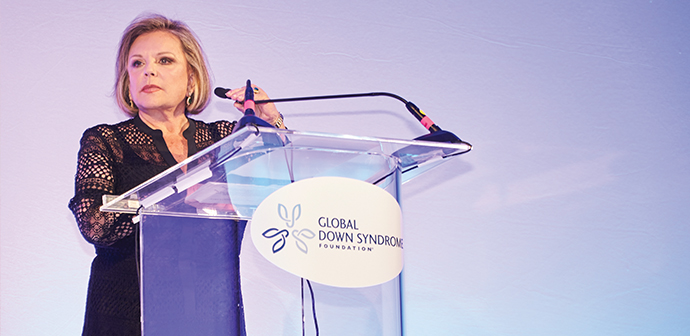
From Down Syndrome World Issue 3 2018
The Salah family and the Salah Foundation are giving countless people hope, life-changing support, and a brighter future. For the Global Down Syndrome Foundation, the Salah Foundation is making its dream come true — the opening of a state-of-the-art education center for the differently-abled.
THE SALAH FAMILY is originally from Lebanon, a country of great maritime and cultural history, where even in the second millennium BC, people living in the area cultivated land in a sophisticated society. The ancient Lebanese were creators of the oldest known 24-letter alphabet, and eventually, their alphabet would influence Hebrew, Aramaic, and other languages throughout the Mediterranean region. More recent history has been tumultuous for Lebanon, including during World War I (1914–1918), after which the country was put under the direct control of France. It was during this difficult time, in 1919, that Joseph and Nora Salah courageously left their Maronite Christian hometown and emigrated from Lebanon to the United States in pursuit of a better life.
With little money and unable to speak English, the Salahs worked hard to make a life for themselves and their three children: Isabel, James, and George. James “Jim” Salah was a natural and brilliant entrepreneur. He started his own construction business in Boston, handling some of the city’s largest utility projects, and then branched out into real estate and heavy equipment leasing, and his companies prospered. Upon his death in 2009, The Salah Foundation was founded and now serves as a living tribute to his lifelong success and generosity. Today, Jim’s commitment to philanthropy lives on through his niece, Noreen Salah Burpee, who serves as Executive Director of the foundation.
A FORMIDABLE FORCE FOR GOOD
Under the direction of Burpee, The Salah Foundation has become a formidable force for good. “We have a special interest in self-sufficiency programs,” Burpee explains. “We seek to improve the lives of the under educated, undernourished, and medically needy to become productive and responsible citizens.” The foundation has an emphasis on the economically disadvantaged, young, elderly, and disabled. “The need for responsible philanthropy is almost overwhelming,” Burpee said. “Our greatest inspiration is when we witness someone breaking the cycle of poverty, or ignorance, or homelessness.” Burpee has tapped her own three children — Fred Churbuck, Megan Fearnow, and George J. Taylor — to share the responsibility of philanthropy. “It is a privilege to work together as a family ,” Burpee explains. “Each board member brings their own personal passions to the table. We are a brave family and not afraid to fund the underserved.” Some important organizations that are close to their hearts include The Salah Foundation’s Children’s Hospital at Broward Health and The Noreen Salah Burpee Adult Infusion Center, an inpatient cancer center, both in Fort Lauderdale, Florida, and most recently, The Salah Foundation Learning Zone at the future Global Down Syndrome Foundation Education Center of Excellence. The Salah Foundation connected with Global’s dedication to research, medical care, education, and advocacy for people with
Down syndrome. When the family learned about the lack of research funding and medical care and the discrimination against people with Down syndrome, Burpee says she was “very moved by each child with Down syndrome and their supporting families. The very thought that their needs and the needs of children like them were
not being met made us very sad.” “Research is the key,” she continues. “People must be educated on the difficulties and lives of these children so they can live productive, meaningful lives, and Global is doing just that.”
 This article was published in the award-winning Down Syndrome World™ magazine. Become a member to read all the articles and get future issues delivered to your door!
This article was published in the award-winning Down Syndrome World™ magazine. Become a member to read all the articles and get future issues delivered to your door!TWO GENERATIONS OF IMPACT GIVING
Burpee’s son, Fred Churbuck, was the first to experience Global at one of our annual Be Beautiful Be Yourself Fashion Show fundraisers. Churbuck admits that at first he didn’t want to attend. “I thought I would feel uncomfortable,” he says. “I had never met a person with Down syndrome.” Then something magical happened. The keynote speaker, Tim Harris, came out, and his speech touched Churbuck. “He was so energetic and articulate, and then he turns to the audience and says, ‘I’m living my dream. You ask yourself, are you living yours? Are you the best you can be?” Churbuck retells the moment. “For the next few weeks, I had all my marketing team watch Tim on video, and we were all inspired.” Over the next two years, The Salah Foundation generously funded Global’s important adult life skills classes and a post – secondary research study that spelled out, for the first time , how adults with Down syndrome best learn life skills and improve their cognitive abilities. “The support that Salah provided to our class and research helped us to make adults more self-sufficient while being able to create and share best practices,” says Bryn Gelaro, LSW (licensed social worker), Global’s Director of Adult Initiatives and Special Projects. Then in 2017, four years to the date of Churbuck at tending Global’s annual fundraiser, the Salah family at tended with a game-changing surprise announcement. Burpee got on stage and announced a new pledge to help under write Global’s future Education Center of Excellence with the lar gest single donation Global has received — $1 million. “We are out of our minds grateful!” says Michelle Sie Whitten, President and CEO of Global. “The Salah Foundation was amazingly generous, and it was so hard to keep it a secret — literally even our board didn’t know. We were so intent on making it a surprise. There were 1,400 people in attendance, we were sold out, and then the lovely, articulate Noreen gets up there and just makes the announcement. Even Quincy Jones, John C. McGinley, Jamie Foxx, and Eva Longoria were high-fiving each other!” Burpee recalls, “When I made that pledge and hear d the gasps and then the applause, I looked to my family’s table and saw them standing and wildly applauding. It took my breath away.” The 2017 Be Beautiful Be Yourself Fashion Show was the largest grossing Global fundraiser to date.
INCLUSION, INSPIRATION, AND ACHIEVEMENT
Global’s future Education Center will open in 2019. The Education Center will house The Salah Foundation Learning Zone where transformative educational programs for adults and children with Down syndrome will be held. To better understand the needs of the local community, Global organized an informal listening campaign and survey resulting in 26 disability organizations identifying programs and classes that could take place in The Salah Foundation Learning Zone. Examples of programs already being planned are cooking classes, computer classes, and summer center-based learning classes so children with Down syndrome can be better prepared for the school year. The Education Center is nestled between the Cherry Creek neighborhood of over 1,000 residents and the vibrant Cherry Creek North shopping district with over 600 businesses and 8 ,000 employees. A key focus of the center will be vocational training with the long-term goal of having 30 to 40 people who are differently abled working in Cherry Creek North. “We are not just a check-writing foundation but a partner in philanthropy,” Burpee says. The partnership with The Salah Foundation and the Salah family will surely empower the dreams of those with Down syndrome and the differently-abled for years to come.
The Salah Foundation is a private foundation that makes investments in nonprofits by invitation only.
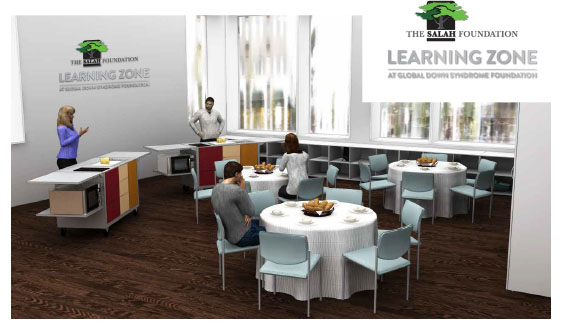
Draft rendering of The Salah Foundation Learning Zone at Global Down Syndrome Foundation Courtesy of OfficeScapes and ArtHouse Design
Like this article? Join Global Down Syndrome Foundation’s Membership program today to receive 4 issues of the quarterly award-winning publication, plus access to 4 seasonal educational Webinar Series, and eligibility to apply for Global’s Employment and Educational Grants.
Register today at downsyndromeworld.org!

 Experience our inspirational and groundbreaking videos and photos. Our children and self-advocates are beautiful AND brilliant!
Experience our inspirational and groundbreaking videos and photos. Our children and self-advocates are beautiful AND brilliant! Make sure your local Representatives are on the Congressional Down Syndrome Task Force.
Make sure your local Representatives are on the Congressional Down Syndrome Task Force.